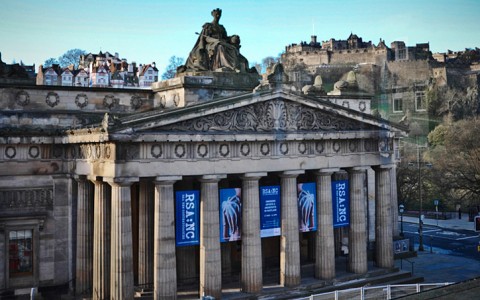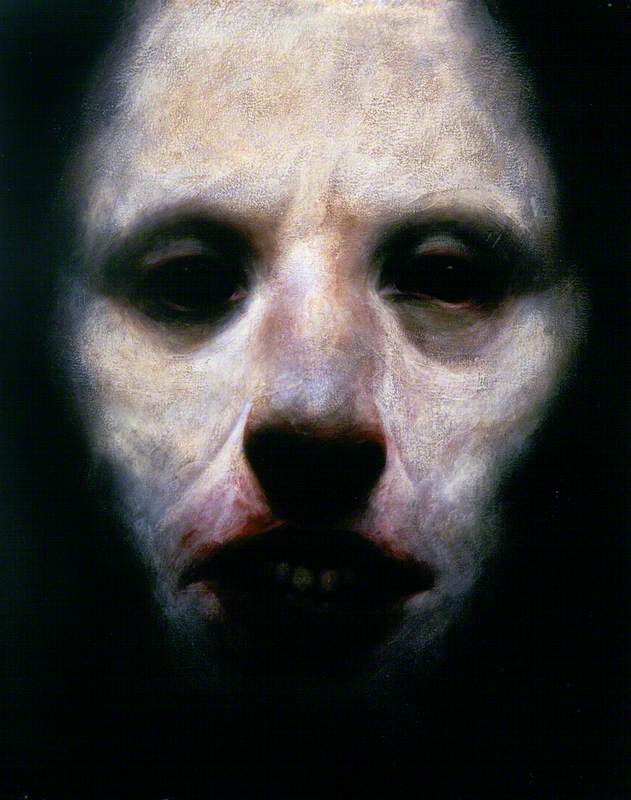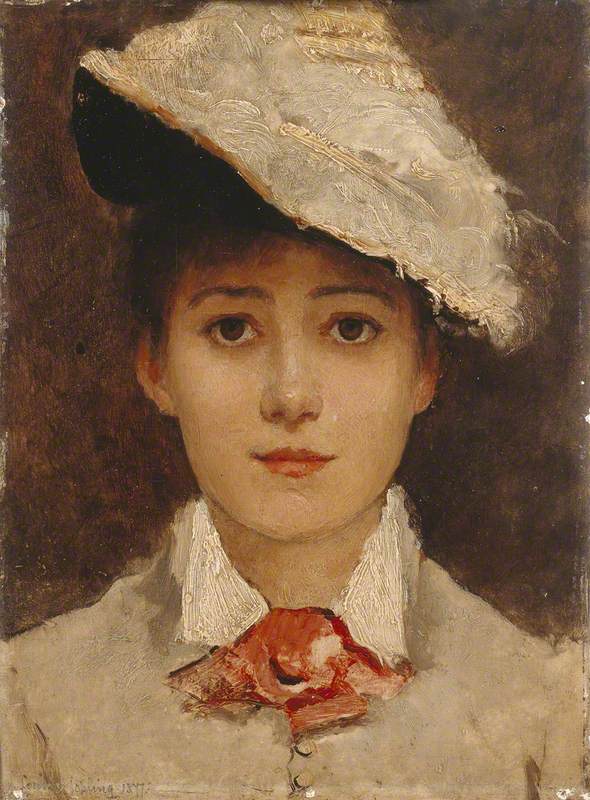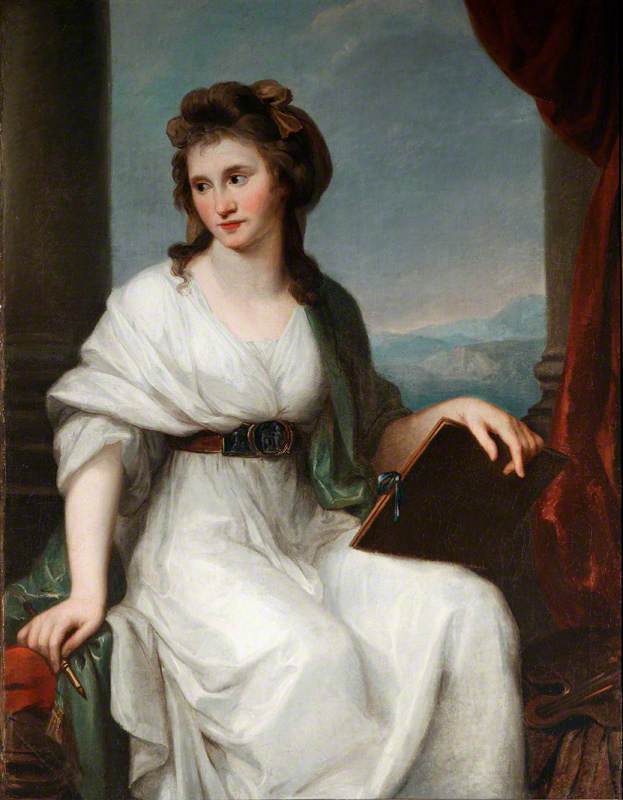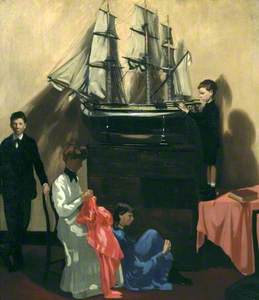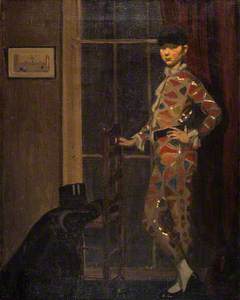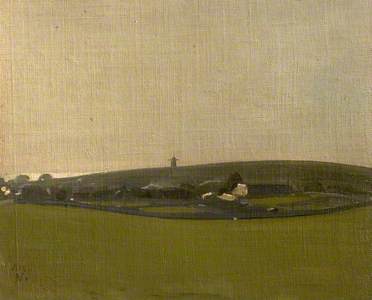Mabel Scott Lauder Pryde was born in Edinburgh in 1871. She was named after her maternal great-uncle, the Royal Scottish Academician Robert Scott Lauder. Her father was Dr David Pryde (1834–1907), a pioneer of education for girls and young women. She grew up in the Scottish capital in the centre of its artistic, literary and theatrical networks, not least through her brother, the artist James 'Jimmie' Ferrier Pryde.
She met William Nicholson in 1888, when they were students at Hubert von Herkomer's art school in Bushey, Hertfordshire. William nicknamed her 'Prydie', an affectionate Scottish-style diminution of her surname, more commonly applied to those of boys and men, by which she was known for the rest of her life. On their marriage in 1893, she became Mabel Nicholson and it was under this name that she exhibited her work.
Their eldest son, Ben Nicholson, became an artist, their daughter Nancy Nicholson became a designer and their youngest son, Kit Nicholson, became an architect. The Nicholsons, including their second son Tony (1897–1918), can be seen in William Orpen's A Bloomsbury Family. Prydie thereafter lived in England, until her death in London in 1918.
Prydie was born into an important artistic dynasty. Her maternal great-uncles, Robert Scott Lauder and James Eckford Lauder, were both members of the Royal Scottish Academy (RSA) and therefore leading figures in the 'fine art establishment'. The brothers trained at the Trustees' Academy in Edinburgh, where Robert worked as a Director between 1852 and 1864. He oversaw the admittance of female students to the institution from 1858, albeit in segregated classes. However, women were not permitted to graduate to the RSA Life School and were thus excluded from drawing from a live model, considered the foundation to becoming a professional artist.
Perhaps of even more significance to Prydie was Robert's daughter (and her first cousin once removed), Isabella Scott Lauder. In Isabella, Prydie had a close relative as a role model of a professional woman artist. Her long career saw her live between Edinburgh and Fife, exhibit at the Glasgow Institute of the Fine Arts (GIFA), later the Royal Glasgow Institute, between 1861 and 1887 and at the RSA for over 30 years. Isabella's post-humous reputation is based on Priscilla, the Puritan Maiden, which was shown at the RSA in 1862 and is now in the collection of Hospitalfield, Arbroath.
Rear View of Elizabeth Gulland's House, Bushey
Elizabeth Gulland (1857–1934) 
Most important was the example set by Prydie's brother, Jimmie, to whom she was particularly close. As a male, he was able to study at the RSA Life Class between 1885 and 1888, before spending three months in Paris, with irregular attendance at the Académie Julian. In 1885, Sir William Fettes Douglas, President of the RSA, declared that the work of a woman artist was 'like a man's only weaker and poorer'. Indeed, at the time, there was not a single female member, of any rank, of the RSA. Is it any wonder that Prydie saw her future beyond Edinburgh?
Prydie lobbied her parents to attend Herkomer's progressive, co-educational art school, which operated between 1883 and 1904 and provided segregated life classes for its female students. Patricia Reed has established a specific link between the Prydes and Herkomer's which is likely to explain how Prydie knew of the school and why she was allowed to attend it. Elizabeth Gulland was born in Edinburgh in 1857 and attended Prydie's father's school. She began exhibiting at the GIFA and RSA before enrolling at Herkomer's in 1885. Gulland remained in Bushey for the rest of her life and practised as a professional artist. She could therefore act as a chaperone for Prydie and a conduit to her family.
Prydie trained at Herkomer's between 1888 and 1891 and it was there that she met William; they eloped in 1893. Marriage was followed shortly afterwards by motherhood. Prydie's career extended over about a decade from approximately 1905 to 1916. Her somewhat ambivalent positioning in the background of Orpen's The Bloomsbury Family is suggestive of the challenges she faced in combining parental and other domestic responsibilities with creative and professional interests.
Nancy as the Harlequin with a Windsor Chair
c.1910
Mabel Nicholson (1871–1918) 
As Lucy Davies has pointed out, Prydie resolved this dilemma by 'viscerally binding' her children into her practice, as can be seen in her portrait of Nancy as the harlequin. Prydie portrayed her children with unsentimental realism, despite or because of her deep attachment to them. She was scrupulous in paying them a modelling fee, as much out of respect for their contribution to her practice as a signifier of her professionalism.
The Windmill, Brighton Downs (Brighton Downs, Rottingdean)
1910
William Nicholson (1872–1949) 
Following Prydie's death, Ben and Nancy organised a memorial exhibition of her work held at the Goupil Gallery in London in 1920. Her paintings were shown in Scotland for the first time when three were exhibited at the RGI that year. The Red Jersey was purchased from the Goupil exhibition by Aberdeen Art Gallery, making it the first of Prydie's works to enter a UK public collection and a Scottish one at that.
The Red Jersey
(Christopher 'Kit' Nicholson, 1904–1948, the artist's son) c.1912
Mabel Nicholson (1871–1918) 
Three further works by Prydie have since entered the Scottish public realm, all held by the National Galleries of Scotland: The Grange, Rottingdean (on loan from a private collection), Study of a Child and Harlequin with Chair. As a result, Prydie has been deemed to be of national importance in her country of birth. She has since been firmly positioned within the Scottish art historical canon, not least by her inclusion in the landmark 'Modern Scottish Women: Painters and Sculptors 1885–1965' exhibition and accompanying book.
From her birth into a Scottish artists' dynasty, to her presence in the country's national collection, Mabel Scott Lauder Pryde Nicholson has been woven into the web of Scotland's art world.
Alice Strang, curator
This content was funded by the PF Charitable Trust
Further reading
Lucy Davies, Mabel Nicholson, Eiderdown Books, 2024
Alice Strang, 'Pryde and Prejudice', The World of Interiors, September 2024, p.56
Alice Strang, 'Modern Scottish Women: Painters and Sculptors 1885–1965', Scottish National Gallery of Modern Art, 2015






